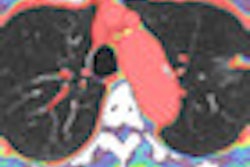NANCY, FRANCE - The word of the day was "dosimétrie," or the measure of radiation dose, at this week's annual Volumetric Scanner Symposium in France. The new focus on dose control represents a sharp shift from previous meetings, which were dominated by discussions of growing CT scanner horsepower.
The change can be attributed to shock waves from Los Angeles, where CT radiation overdoses in 2009 at Cedars-Sinai Medical Center prompted a U.S. Food and Drug Administration (FDA) investigation and new medical radiation protection laws.
The theme for the symposium was set early at the meeting, with images of patients burned by radiation overexposure presented in the opening address by Alain Blum, MD, PhD, with the University Hospital of Nancy, who organized the event.
In an instant poll of the 400 participants during the plenary session, 92% responded that dose reduction is the most important feature they will seek in new CT equipment in the coming year. Increasing the number of detector rows in a scanner finished a poor second, with 4% of the vote.
In the morning sessions, traditionally devoted to innovations from manufacturers of scanners, speakers were quick to link new product features to dose reductions that they claimed would range from 60% to as high as 90%.
Each manufacturer promoted next-generation iterative reconstruction processing capabilities to be launched at the upcoming European Congress of Radiology (ECR) set to take place March 3-7 in Vienna.
Antoine Jomier from GE Healthcare of Chalfont St. Giles, U.K., said his company now targets a threshold of 1 mSv for all routine applications.
Marc Zins, MD, from the Hôpital Saint-Joseph in Paris, who chaired a session on dose measurement and radioprotection, said that "for years manufacturers have been concerned only with improving image quality regardless of the dose, and now they have gone to the other extreme, way too low."
Heavy footprint
The heavy radiation footprint of CT exams in France was a reference point for several speakers in the session. They reported that in 2007 just 7% of all medical exams in France using radiation were performed by CT, yet this modality accounts for 36% of the total annual irradiation of patients. This translates to more than 61 million exams with an exposure totaling 40.4 million mSv.
Radiation in medical imaging is regulated in France by laws passed in 2004 and again in 2006. Yet the Institute for Radioprotection and Nuclear Safety (IRSN), which is responsible for enforcement, reported that five years after the enactment of these laws, their application remains "limited, with fewer than one clinic in four having sent reports conforming to the regulations."
Despite an overwhelming agreement among the radiologists at the CT symposium that radiation needs to be reduced, it was not clear how they plan to lower the dose. In an instant poll of the audience during the radioprotection session, 72% replied they are counting on a software solution to reduce dose.
One such software-based approach tracks actual dose delivered during an exam and creates patient histories. Luc Mertz, PhD, from the University Hospital of Strasbourg, explained how his group uses a dose tracking software application called SerphyDose to reduce radiation from 17% to 52%, depending on the protocol.
The second approach involves using iterative reconstruction techniques now becoming available on many CT scanners. Following up with a dozen participants after the session to clarify which software approach they intended to use, all said they were counting on using what was called the "magic button" of iterative reconstruction. None said they were planning an approach using software to track radiation exposures.
In her presentation on urological scanning, Catherine Roy, MD, from the University Hospital of Strasbourg, who also leads the radiology group at the Hôpital Civil in Strasbourg, explained how by reducing the region of interest (ROI), reducing kV, and modulating the mAs, radiation was dropped by 30% to 50%.
"We are now pushing this software to see if we can't do even better," she said, encouraging colleagues to adjust manufacturer settings for iterative reconstruction for either further reductions in radiation or improvements in spatial resolution.
Patrik Rogalla, MD, from the University of Toronto, also urged radiologists in the session to "reset the presets" of iterative reconstruction. Specifications for image manipulation by software can be reconfigured in the image domain or in the raw data domain, he explained.
"There is no question that these different-looking images are going to become the mainstay, and at some point submillisievert imaging will be a clinical reality," he said. "The future of CT will be in what we can pull for diagnostic purposes from otherwise unacceptable images at low dose."
By John Brosky
AuntMinnie.com contributing writer
January 27, 2011
Related Reading
U.K. radiation exposure lower than in other countries, January 5, 2011
Pediatric CT dose is low but varies widely in Belgium, April 23, 2010
CT doses, widely variable in Europe, are reduced by staff efforts, March 6, 2010
320-row CT minimizes dose in pediatric abdominal studies, March 3, 2010
Copyright © 2011 AuntMinnie.com




















